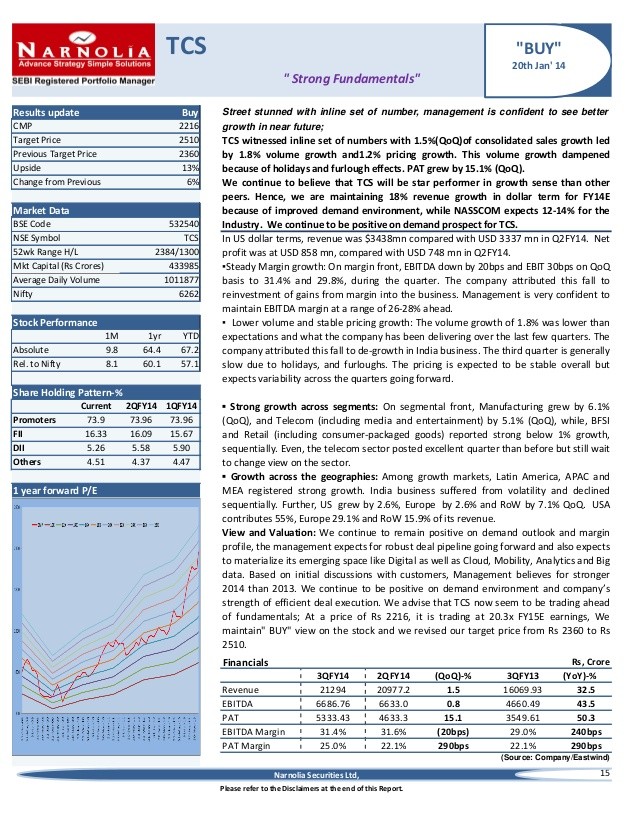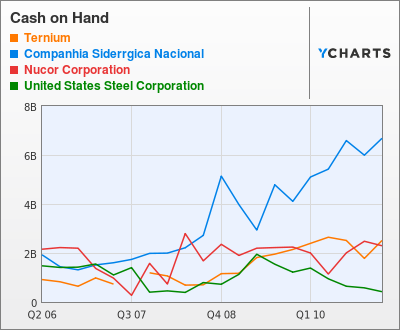3 Cheap Material Stocks With Strong Fundamentals
Post on: 16 Март, 2015 No Comment

Analysts are generally cautious about the sustainability of the Materials industry’s high profit margins, which may not sufficiently reflect lower commodity prices or even China’s economic slowdown.
Commodity prices peaked last 2011 and have generally trended downward as China — one of the world’s largest consumers of major metals — has reported seven consecutive quarters of lower GDP growth through 2012.
Despite these obstacles, revenues for the mining industry are at a 10-year high and profit margins still reflect near-record high commodity prices.
Discussed below are three undervalued Material companies with strong fundamentals and sustainable earnings growth.
Source: Yahoo Finance
Access Midstream Partners LP (NYSE:ACMP ) is a midstream gathering MLP with U.S. gathering pipelines and facilities. According to Access Midstream’s website. it has established a large-scale position in all of the key unconventional basins in the U.S.
- Post Acquisition Guidance. Access Midstream Partners completed its Chesapeake Midstream Operating LLC (NYSE:CMO ) acquisition last December 2012. ACMP management changed its EBITDA and capex guidance after the acquisition. EBITDA guidance increased to $800 to $850 million in 2013, and $1.0 to $1.1 billion in 2014, implying an acquisition valuation of an estimated 12X for 2013 and 9.3X on 2014.
- Economies of Scale. Following the acquisition, ACMP will own and operate G&P assets in 10 major plays (up from seven previously), including liquids-rich basins (Eagle Ford, Utica, Niobrara, Mississippi Lime, Granite Wash/Colony Wash, Wolfberry, Permian) and dry gas basins (Marcellus, Barnett, Haynesville).
- Capital Expenditures. Guidance for maintenance capex was likewise increased from $74 million to $110 million annually (2013 to 2014). As a percentage of EBITDA, maintenance capex held largely in-line, with 13.8% in 2013 (versus 13.3% previously) and 11.8% in 2014 (versus 10.5% previously).

- Cost of Capital. Barclays estimates the deal to be accretive given ACMP’s competitive cost of capital. The investment bank increased its five-year distribution CAGR (compounded annual growth rate) to 12.2%, up from 11.3% previously, which includes 14% to 15% distribution growth in 2013 going to 2014.
- Concentration Risk. As Chesapeake Energy Corp.’s (NYSE:CHK ) midstream provider, ACMP has a heavy concentration of business with CHK. Prior to the acquisition deal, CHK represented 72% of ACMP’s business, though ACMP management previously stated it targets to reduce it to 50%. With the closing of its asset purchases from CMD, CHK gained a number of new customers to its portfolio. ACMP’s customer base is now comprising Chesapeake, Anadarko (NYSE:APC ), ExxonMobil (NYSE:XOM ), Shell (NYSE:RDS.A ), Statoil (NYSE:STO ), Mitsui (OTCPK:MITSY ), Total (NYSE:TOT ) and Enervest (OTC:EOSOF ). However, the percentage of business generated from CHK is expected to be modestly higher, reaching 75% to 80% post-close.
- Price-to-Book Valuation. Price-to-book of ACMP is 1.9X. This is 62.82% lower than that of the Basic Materials sector, and 67.07% lower than that of industry price-to-book. The price-to-book for all stocks is 67.85% higher than ACMP.
Denbury Resources (NYSE:DNR ), with headquarters in Plano, Texas, is a growing independent oil and gas company. The company is the largest oil and natural gas producer in both Mississippi, and Montana, owns the largest reserves of carbon dioxide (CO2) used for tertiary oil recovery east of the Mississippi River, and holds significant operating acreage in the Rocky Mountain and Gulf Coast regions
- Oil Production. Denbury Resources ended 2012 on a strong note with oil production growing 8% year-on-year. The midpoint of management’s 2013 guidance of 36.5 to 39.5 million barrels/day implies that volumes remain relatively flat compared to the fourth-quarter run-rate, which is conservative.
- Revenue Growth. Growth will continue to hinge on the performance of DNR’s newest floods at Oyster Bayou and Hastings Field with more modest contributions from prior phases. Its CO2 flood at Bell Creek, its first in the Rockies, is expected to post its first oil production in 2013 and will likely have a greater impact on production in 2014.
- Financial Flexibility. As of December 2012, DNR had $3.1 billion in total debt and $1.15 billion of cash, implying a net debt-to-capital ratio of 28%. It had $700 million drawn on its credit facility, which has a borrowing base of $1.6 billion. It completed the sale of $1.2 billion of 4.6% senior subordinated notes due 2023. Proceeds will be used to redeem all $651 million of its 9.5% and 9.75% senior subordinated notes due 2016 and repay bank debt.
- Share Price. DNR’s visible, long-term oil growth and leverage to robust oil prices justifies a price premium in share valuation.
- Price-to-book Valuation. The price-to-book ratio of Denbury Resources is roughly 1.21X. This is 76.23% lower than that of the Basic Materials sector, and 78.7% lower than that of the industry price-to-book. The price-to-book for all stocks is 79.56% higher than the company.
Royal Gold Inc. (NASDAQ:RGLD ) is a Denver based company involved in the acquisition and management of precious metal royalties and similar interest, including precious metal streams.
- Gold Outlook. Gold, which has risen for 10 consecutive years, reached a record $1,923.70 an ounce on Sept. 6, 2012. The metal has already gained 21% this year, as investors seek a haven amid Europe’s debt crisis and plunging equity markets.
- Royalty Revenues. Royal Gold, Inc. reported royalty revenue of $79.9 million for its second quarter of 2013. EBITDA came in at $73.4 million, which is 92% of total revenues, thanks to robust royalties and streaming business models.
- Gold Production. Strong copper mine production allowed the company to see a 16% increase in net earnings, even though the average realized gold price saw only a 2% increase.
- Other Resources. Royal Gold owns royalties on assets owned by companies including Barrick Gold Corp. (NYSE:ABX ), Teck Resources Ltd. and Goldcorp Inc. Royal Gold sources its revenue from mining royalties. The company is on track to sign more deals with companies seeking financing for project development as costs increase.
- Company Outlook. Chief Executive Officer Tony Jensen said in a press statement, It is a deal-rich and opportunity-rich environment. This is a very good environment for us.
- Price-to-book Valuation. The price-to-book ratio of Royal Gold is estimated at 1.43X. This is 71.91% lower than that of the Basic Materials sector. and 66.35% lower than that of the industry’s price-to-book. The price-to-book for all stocks is 75.84% higher than the company’s.
Disclosure: I have no positions in any stocks mentioned, and no plans to initiate any positions within the next 72 hours.
Business relationship disclosure: Black Coral Research, Inc. is a team of writers who provide unique perspective to help inspire investors. This article was written Hans Centena, one of our Senior Analysts. We did not receive compensation for this article (other than from Seeking Alpha), and we have no business relationship with any company whose stock is mentioned in this article.
Disclaimer: Black Coral Research, Inc. is not a registered investment advisor or broker/dealer. Readers are advised that the material contained herein should be used solely for informational purposes. Investing involves risk, including the loss of principal. Readers are solely responsible for their own investment decisions.














